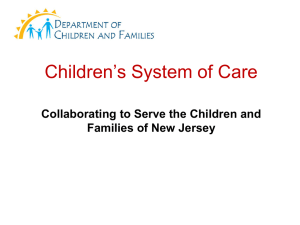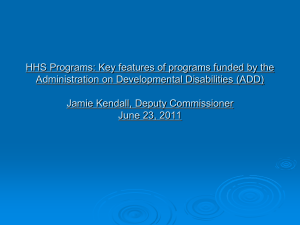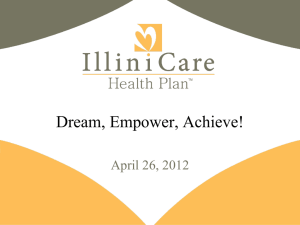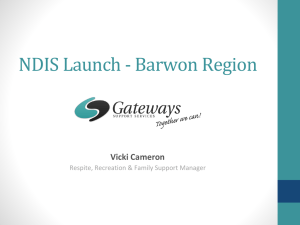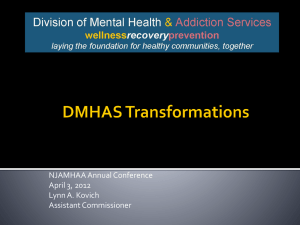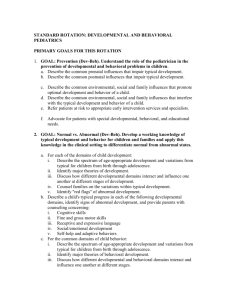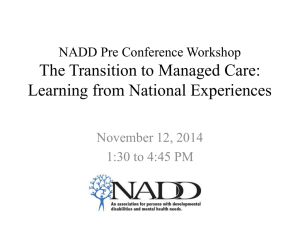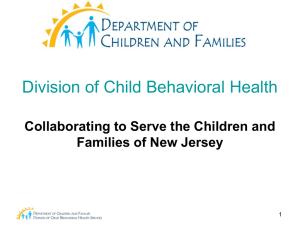Handout 2
advertisement
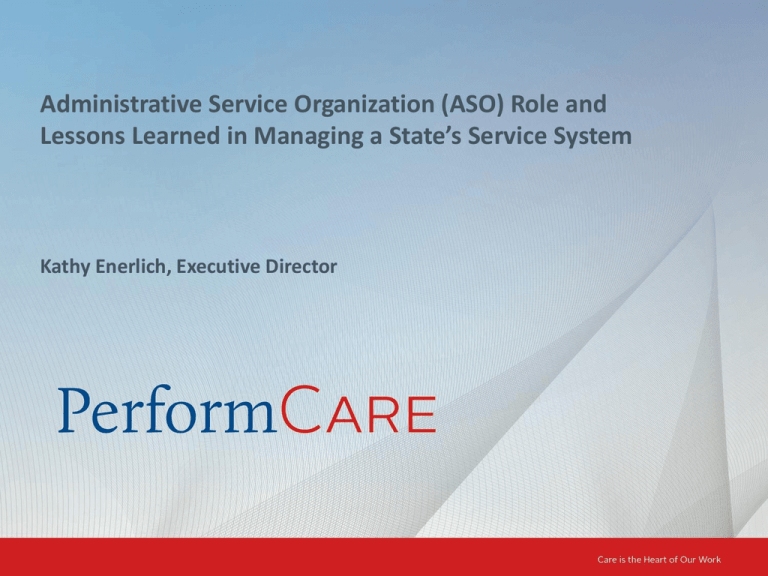
Administrative Service Organization (ASO) Role and Lessons Learned in Managing a State’s Service System Kathy Enerlich, Executive Director Challenges of rapid, large-scale system transformation impacting leadership, the provider community and families. Objectives Lessons learned and strategies for system of care integration for individuals with developmental disabilities and cooccurring mental illness. 1 Quick Look - Who We Are PerformCare is a full-service managed behavioral health care organization (MBHO) that supports individuals and providers through programs in both the public and private sectors. Founded in 1994 by a group of leading behavioral health providers, PerformCare is a member of the AmeriHealth Caritas Family of Companies, one of the largest Medicaid managed care organizations in the United States. PerformCare is NCQA Accredited. 2 PerformCare NJ As the Administrative Service Organization (ASO) for the State of New Jersey's Division of Children's System of Care (CSOC) since 2009, PerformCare New Jersey utilizes significant expertise and integrated technologies to register, authorize, and coordinate services for children, youth, and young adults who are experiencing emotional and behavioral challenges, are developmentally and intellectually disabled or need certain substance use treatment services. 3 Who is integrated? The NJ Children’s System of Care serves: Behavioral health: Youth with moderate to severe needs, entire NJ population (over 45,000 youth in the last fiscal year). Child welfare: Youth with child welfare involvement and a treatment need. Developmental disabilities: Youth eligible for services based on regulatory definition of functional impairment (over 17,000 youth). Substance use: Youth who are underinsured and have a treatment need (1143). Housing: Young adults experiencing homelessness (573). 4 Historical Perspective* July 2012 2006 1999 NJ wins a federal system of care grant that allowed NJ to develop a system of care. 2001 NJ restructures the funding system that serves children. Through Medicaid and the contracted system administrator, children no longer need to enter the child welfare system to receive behavioral health care services. The Department of Children and Families (DCF) becomes the first cabinet-level department exclusively dedicated to children and families [P.L. 2006, Chapter 47]. Intellectual/developmental disability (I/DD) services for youth and young adults under age 21 is transitioned from the Department of Human Services (DHS) Division of Developmental Disabilities to the DCF Children’s System of Care (CSOC). July 2013 Substance use treatment services for youth under age 18 is transitioned from DHS, Division of Mental Health and Addiction Services, to DCF/CSOC. 2005 Closed State Psychiatric Hospital For Children 2007 – 2012 May 2013 The number of youth in out-of-state behavioral health care goes from more than 300 to three.* Unification of care management, under CMO, is completed statewide. December 2014 Behavioral Health Home Pilot *How did NJ do this? Careful individualized planning and the development of in-state options (based on research about what kids need) using resources that were previously going out of state. *Source-State of NJ Division of Children’s System of Care PowerPoint System Foundation Child Centered & Family Driven Community Based Culturally Competent Outcome Based Needs Driven Accessible Strengths Based Family Involvement Individualized Unconditional Care Collaborative Home, School & Community Based Promoting Independence Cost Effective Team Based Comprehensive System of Care Vision* To help youth succeed… At home Successfully living with their families and reducing the need for out-of-home treatment settings. At school Successfully attending the least restrictive and most appropriate school setting close to home. In the community Successfully participating in the community and becoming independent, productive and law-abiding citizens. *Source: NJ Division of Children’s System of Care slide The ASO’s Role as a Partner with the State Vision/policy for system of care Access to Care: 24/7/365 single point of contact for families Setting data collection priorities Developing/enhancing electronic medical record Using data to refine service array Data collection, reporting and trending Contract management and service line manager Provider training, communication, technical support Rate setting, new services (via notice of funds availability), funding priorities Leverage braided and blended funding streams to maximize services and availability of Federal Funding Participation (FFP) Defining new service and population rules, Rapidly implementation ensuring capacity for new requirements, and criteria, ensuring compliance with services/populations statutes and regulations Reasons for Integration of Developmental Disability Services* “Synchronized service coordination and elimination of duplicate services. Support sustainable communities and balanced resource coordination. Bring all children’s services into a single department. Further current progress and achievement of strategic objectives of the Department of Children and Families.” Source: NJ Division of Children’s System of Care slide 9 State Leadership Challenges How do you handle uncertainty, ambiguity and rapid change? Workforce competencies Reexamination of service models: not merely managing but transformation treatment. Shifting certain responsibility from a state entity to ASO. Policy makers faced with no new dollars Building an accountable oversight structure Building a fair, equitable service model to access services based on level of need. 10 State Leadership Strategies Understand and communicate the vision of where you are going. Recall the vision when things get murky. Be transparent to all system partners - families, providers, staff and state, giving current status and acknowledging challenges. Provide comprehensive training to system providers perhaps through a university contract. Share and report progress regularly. Develop partnerships with family, and with advocacy and provider groups and organizations. Be flexible and acknowledge what you don’t know yet. Know who is responsible for what messaging. 11 Provider Challenges Looking to a new entity for solutions (ASO) How can you organization provide greater value? (strength-based treatment, access to care, quality standards, outcomes and cost effectiveness) Processes for budgeting and monitoring of revenues Use or interact with a new IT platform (foundation for data collection) Provide improved access 12 Provider Strategies Accountable oversight structure that defines and monitors: • Organization’s role and position in the market. • Staff productivity • Documentation and treatment planning – and progress against identified goals (quality standards) • Standardize process for client flow from initial request • Project revenues, deficiencies, surplus, break-even • Understand program utilization and if you are meeting utilization benchmarks – data driven performance. 13 Data Challenges Agreeing up front on what really matters. Common definitions are needed to crosswalk definitions and data sets. Technical questions: how do we get the file? Privacy concerns: who owns the data, and what can be seen or shared? Setting priorities for “Day 1” reports. 14 Data Strategies Get the right people in the room: content experts, decision makers (all sides), data analysts and IT. Recognize that “the perfect is the enemy of the good.” Having some kind of data decision points early is critical – then fine tune. Need for specialized data collection: expanded modules for CANS tools, Level of Care Indicator (LOCI) and custom family support application. Build reporting functions to capture discrete data for service penetration and utilization, and track braided funding of unique youth populations. 15 Family Engagement Address system change and worries early on with families • Behavioral health: will the system forget about us? • Developmental disabilities: do you really understand what we need? • Substance abuse: will it be more difficult to access services? Establish stakeholder groups • State-stakeholder group. • ASO-family leader group. Be in front of families frequently 16 Where are we now? Intellectual and developmental disabilities with dual mental health diagnoses 1915(c)-like pilot program The primary goal of the DD/MI program is to provide a safe, stable and therapeutically supportive environment in the community for children and young adults with significantly challenging behavior needs. • ensure the safety of the child or young adult and all participating staff by providing individual specific training and on- site technical supports; • decrease elopement risk and safeguard the environment by providing one-time funds to ensure safety; • keep families united by placing the child or young adult in close proximity to the individual’s family or guardian in the least restrictive setting; • reunite the child or young adult with the family whenever possible 18 New Services for DD/MI Youth Under the Pilot the DD/MI youth can receive these new services: Case/Care Management Individual Supports Natural Support Training Intensive In-Community (II-C) Habilitation Respite Non-Medical Transportation Interpreter Services 19 Intensive In-Home Services Intensive In-Home (IIH) services specifically Behavioral Interventions and Clinical Therapeutics were designed and are being implemented. Our role in the design impacted the treatment plan - allows users to input clinical information such as the youth’s Needs and Strengths, as well as Strategies, Techniques and Barriers to treatment. The user can see all the associated information at once. 20 Optimally Managed Through Innovative Solutions Family Support Services Application - ensures resources are prioritized to families with greatest needs. Family Portal - electronic eligibility application reduces family burden and increases operational efficiencies. DD Eligibility Average Decision Time - Reduced from 195 days to 49 days with improved information for families through clinical and administrative processes. Restructured Electronic Record & Consent Process - for exchange of substance abuse information in compliance with 42 CFR-Part 2. 21 Assessing Family Support Service Needs (Respite) Use of a standard tool that: Assesses capability of the family to care for the youth Identifies special needs of the youth requiring care Considers individual family factors 22 Family Support Services Application for DD Eligible Youth Single point of access for Family Support Services that consist primarily of respite services & assistive technology. Assesses the caregiver’s ability to support the youth in the community. Scored based upon severity of needs of the youth, caregiver, and family. Challenged to increase the number of families receiving FSS and number of new families without increasing costs. 23 Family Support Services Summary of Aggregate Assessments From January 1 to September 30, 2014 a total of N=3,358 FSS applications for services were received. 24 DD/ID Youth Authorized Mobile Response 23% - diagnoses with moderate-severe medical disability 57% - had a prior MRSS dispatch within prior 12 months 83% - caretakers reported aggression requiring Mobile Response 50% - families cited school or afterschool difficulties as main problem 25 Outcome of Mobile Response 100% resulted in de-escalation of harmful, disruptive behaviors Families reported services were helpful & beneficial Families became aware of other resources & how to access them Mobile Response consistently made collateral contacts with youth’s treating providers or agencies involved to communicate needs & coordinate service delivery 60% referred to the Care Management Organization for ongoing care management 26 Expanding Services While Keeping Down Costs As youth with Intellectual/Developmental Disabilities were added to the population served by PerformCare, we linked them to needed family support services without raising costs – providing more efficiency to the system, and better distributing care. 7000 2012 5838 6000 2013 In 2014 PerformCare estimates that some 10,000 BH services will be authorized for DD youth. 5210 5000 4000 4,582 $5,034 2014 $4,216 3839 $3,309 3124 $3,078 DD Youth with BH Services Cost Per Youth 3000 1,813 2000 1562 1021 1000 0 DDYouth Questions?
